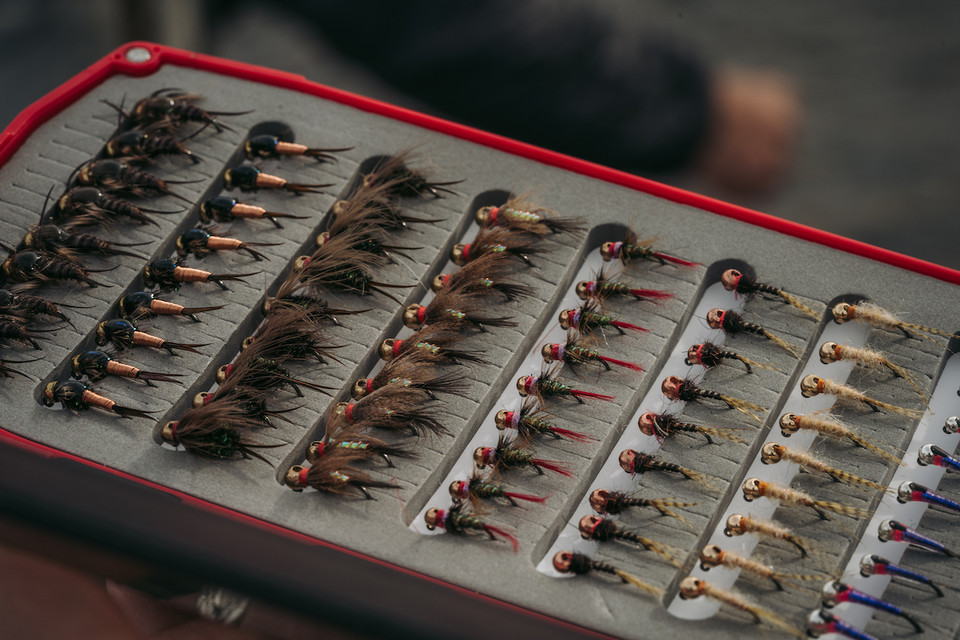
Fly Weight
Fly Weight
There are many variables to consider when choosing the right weight of nymph to tie on your rig. As flies have innovated, lots of thought has gone into the different properties of how effectively a fly can sink. In addition to this, many of the nymphing rigs today also incorporate an added weight to the leader like lead split shot that will help your flies descend into the depths.

The first thing to consider is the type of weight tied into a fly, whether it is wraps of lead under the body, brass beads, or tungsten beads. A simple brass bead should be considered you lightest option, and is often accompanied by split shot applied to the leader.
These serve a good purpose when trying to keep your flies off of the bottom of the river, but at the same time have something to help assist keep your flies in the zone. The zone where fish are feeding is something you need to pay close attention to so that your flies are actually setup at the right depth and fishing effectively without having to start your drift way above your position, leaving room for too much slack line management to effectively set the hook when it comes time.

The second form of bead that perhaps has become the more popular choice is the tungsten bead. Tungsten by nature is about 1.7 times denser than lead, making it the most effective way to sink your fly without necessarily needing to use an additional weight on your leader.
Tungsten beads can come counter sunk, slotted, and most recent is the inverting. Within these three style beads there is even difference in weight for the same diameter. It comes down to how much tungsten has been bore out of the bead to accommodate the style hook you are using.

The materials chosen to make a fly is the second thing to keep in mind when questioning a fly’s sink rate. A more traditionally dressed nymph with dubbing and a hackle of sorts, will have more resistance to penetrating through the water than let’s say a thread bodied fly.
In fact, if you were to apply the same size bead to these two styles of flies on the same size hook, the thread body fly will most certainly cut through the water columns much quicker. This is not disqualifying the traditionally dressed fly, but merely pointing out that if you are trying to sink it quick that you would need to apply more split shot or more weight to the fly.

Let's take a minute to talk about some of the more popular nymphs today and breakdown the efficiency. One of the most popular nymphs that Umpqua Feather merchants has to offer is the Two Bit Hooker by Charlie Craven, He has designed what looks like a more traditional profile nymph with two tungsten beads so that it will not run into any trouble trying to sink in the water.
This is a great fly when you need to have that bigger profile with the realistic anatomy on an insect. It also features a thread body that is coated with a glue to not only make it durable, but to be able to cut through the water more efficiently than a natural material like dubbing.

Perdigons are another very popular style nymph that has come to light in recent years, and is very purpose built. In Spanish it means “pellet”, referring to a shotgun pellet which is typically made of lead. Its sleek design consists of a tungsten bead, a very slim profiled body sealed by glue, and a tail(typically).
Perdigons are perhaps the most efficient sinking hook on the market for the amount of weight that they are tied with which makes them a wonderful option when fishing a dry dropper in heavier water where you still need a smaller imitation.

The last style fly to talk about here is Umpqua’s new Jig Bomb series of nymphs, that are offered with inverting beads. The inverting beads have the least amount of tungsten taken out of them to accommodate for the hook making these you most dense bead option for a nymph.
More typically used in a ”Euro “ style of fishing, these act as the most effective way to sink your fly in the river and keeping it down. There is a whole series of “Bomb” flies that are offered in different weights while still on the same size hook, allowing the angler to finally tune their weight distribution.

